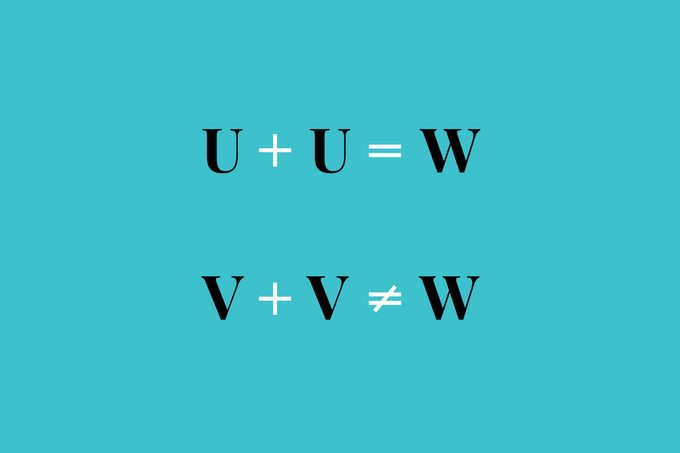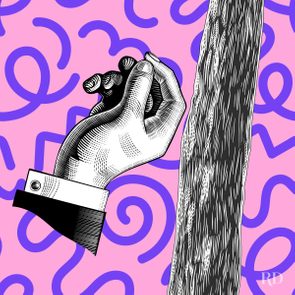Discover the curious history behind this wacky and wonderful letter of the alphabet

This Is Why “W” Is Pronounced Double U and Not Double V

Back when you first learned the alphabet, you probably didn’t realize that one of those letters was not like the others. Unlike its 25 single-syllable siblings, W is the only letter whose name takes three whole syllables to say. Go ahead, sing “The ABC Song” to confirm that statement. I would too.
But that’s not the only oddity about the 23rd letter of the alphabet. W’s name doesn’t even hint at the sound it makes (unlike, say, B, D or T). It’s not pronounced /wuh/, like the whispering sound the letter brings to words like whale and wonder. W’s name isn’t tied to its sound at all—it’s a historical nod to its origins.
So how did this letter land such a strange moniker? Why is W called “double U” when it looks like “double V”? To get to the bottom of this letter-perfect mystery, I turned to two linguistics experts: Michael Adams, PhD, a professor of English and linguistics at Indiana University, and Grant Barrett, a linguist, lexicographer and co-host of the radio show A Way with Words. Read on for a lesson about the ABC’s that you didn’t learn in preschool.
Get Reader’s Digest’s Read Up newsletter for more grammar trivia, humor, travel, tech and fun facts all week long.
The letter W’s origin story

To understand the strange case of why W is called “double U,” we must journey back more than 1,000 years.
Latin alphabet
“The main thing to understand is the Romans did not have the letter W,” says Barrett. In Latin, the letter V served double duty, representing both the vowel sound /u/ and the consonant /v/.
“No natural language uses an alphabet that accommodates all of the sounds in that language, though some come pretty close,” says Adams. “We search for ways of representing the sounds with the letters we’ve got, rather than increasing the number of letters.”
Enter Old English
“Things got complicated,” Adams says, “when you take the Latin alphabet and apply it to a language that has different sounds,” like Old English, a Germanic language with its own runic alphabet (called futhorc). It quickly became clear that Latin’s alphabet was missing a key piece: a symbol for the /wuh/ sound, which was common in Anglo-Saxon speech but nonexistent in Latin.
The UU workaround
Early medieval scribes needed a new symbol. Their solution? Double the letter U—which, at the time, was visually interchangeable with V. In cursive, the rounded form (U) was more common, while the angular V was used in inscriptions and formal settings.
By writing UU to represent the /wuh/ sound, scribes created what eventually fused into a new letter: W. This new form started appearing around the seventh century, initially as two separate characters; by the 11th century, it was regularly written as a ligature, a joined glyph we now recognize as W.
The Wynn detour
In the eighth century, the UU form was temporarily replaced by ƿ (wynn), a character from the runic alphabet used in Old English. For a while, wynn became the standard symbol for W.
That is, until the Norman Conquest in 1066. Barrett explains: “The French and the rest of southern Europe didn’t use those runic letters; they belonged to alphabets from the north. Most European cultures were looking to Rome and Greece and antiquity as their educational reference points. So it made sense for them to throw the letters out.”
“I’m talking as if this was like one great act,” adds Barrett. “It was not a great act. It was just a centuries-long leaning toward this other alphabet reference and then later became standard.”
By about 1300, the wynn character had faded entirely from use, and W as we know it became standard.
But why is W “double U” and not “double V”?
In handwritten medieval manuscripts, where cursive was dominant, W truly looked like two Us. The angular and blocky V, however, was better suited to carved inscriptions and later to printing presses, so in printed materials, W looked like two Vs next to each other.
But, says Barrett, “the name ‘double U’ sticks around, even though the typography of the language changes by the 15th century.” Changing the name would have disrupted an already entrenched convention. And English, a language known for its quirks and borrowings, did what it often does: It stuck with the original name. And that’s why W is called “double U.”
How is W pronounced in other languages?
English isn’t the only language that had to adapt when Latin’s limited alphabet fell short.
“It’s still called ‘double V’ and not ‘double U’ in numerous European languages, including French, Spanish and Italian,” says Barrett. In German, W is simply called veh, and pronounced like an English V.
Most European languages that use the Latin source alphabet, Barrett notes, “have the W only because they borrowed English words like whiskey. Otherwise, they wouldn’t have it. And even then, it’s recognized as unusual and strange in their own languages. It’s like us using an n with a tilde over it for jalapeño.”
The W in the modern world
Today, “double U” can be a source of confusion. It’s one of the few letters of the alphabet whose name doesn’t correspond phonetically to its sound—at all. Try explaining to a child or someone from another country learning English that “double U” stands for the /wuh/ sound. It’s not like it makes any sense (unless you’ve read this article).
And, ironically, the letter’s pronunciation can make spelling things out loud feel clunky—especially in our digital age, when saying “double U double U double U” takes longer than saying “World Wide Web.”
So the next time you’re spelling out a web address or teaching a child the alphabet, remember: W is “double U,” not “double V,” because some historical habits often stick around long after the reasons behind them have faded.
About the experts
|
Why trust us
At Reader’s Digest, we’re committed to producing high-quality content by writers with expertise and experience in their field in consultation with relevant, qualified experts. We rely on reputable primary sources, including government and professional organizations and academic institutions as well as our writers’ personal experiences where appropriate. For this piece on why W is called “double U,” Jo Ann Liguori tapped her experience as a copy chief and editor for national outlets. We verify all facts and data, back them with credible sourcing and revisit them over time to ensure they remain accurate and up to date. Read more about our team, our contributors and our editorial policies.
Sources:
- Michael Adams, professor of English and linguistics at Indiana University Bloomington and author of Slayer Slang: A Buffy the Vampire Slayer Lexicon; phone interview, June 11, 2025
- Grant Barrett, linguist, lexicographer and co-host of A Way with Words, a national radio show about language; phone interview, June 13, 2025
- Oxford English Dictionary: “W”
- Dictionary.com: “What Does the Letter ‘U’ Have to Do With ‘W'”























